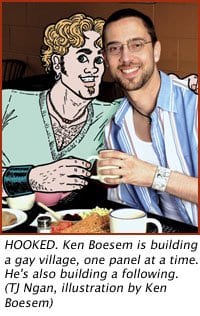It’s hard to believe he’s a substitute teacher by day. Local comic artist and writer Ken Boesem is bookish looking, but a hand grenade on his T-shirt sits defiantly above the words “Pull the Pin.” A mischievous twinkle in his eye hints at something just waiting to jump onto a page.
Boesem joins the Capital Xtra family with a syndicated comic, The Village, which will appear in each new edition of the paper. The comic, set in Vancouver’s gay village, began appearing in Xtra West in 2006.
But don’t worry, we’ll catch you up, Saturday-CBC-Coronation-Street style. Right from the beginning.
When he isn’t trapped on a three-day substitute teaching call that has extended into a month, Boesem can undoubtedly be found drawing — and as much as is physically possible.
“I’m drawing all the time,” he notes as he clutches his customary case of pencils and paper. “I spend an inordinate amount of time at Melriches just drinking tea and drawing. I don’t know if I could actually not draw. It’s so much a part of who I am. When trying to explain something to somebody, my first instinct is to grab a pencil and draw it for them,” he smiles.
Boesem and his company, Barking Raven Press, made news last year when his comic 1918, a reflection on the eponymous year’s spread of the black plague, was included in the prestigious SPX Anthology of comics. The work, devoid of dialogue, solemnly displays a chain of events leading to the deaths of 850,000 in the US from the Spanish flu.
Boesem’s meticulous stroke and his uproariously funny sense of caricature have created clean lines and bubbling characters that look like they have been digitally retouched when they have simply been outlined by hand.
His own gay childhood and coming out story were not quite as exciting. His tacit outing by his mother was not nearly as fantastical as Monty’s existence and definitely did not involve a psychologist.
He easily breaks into a smile when he mentions the name and main character of his 2005 graphic novel, It’s Monty!
“The premise of the story is it’s a little boy at seven-years-old and he’s as gay at seven as some people at 35,” he laughs. “His mom is always wearing these 1950s clothes and is totally clueless to the fact that he’s gay and she makes him mix martinis for her.”
“About 13 years ago — for reasons completely disconnected from reality — [my mother] thought that I might be [gay] so brought it up in conversation,” Boesem remembers. “It took her a couple of years to wrap her mind around it but now it’s all good.”
Nor did Boesem have the privilege of being inconspicuously gay for his whole life.
Come university, Boesem took it upon himself to establish a strong queer presence at Okanagan University College in Kelowna through his revival of the local student newspaper, The Phoenix.
He also revamped the local gay publication, a welcome upgrade to a magazine from a newsletter, and was active in the creation of queer resource groups including a local chapter of Pride.
Boesem’s first comics with a queer theme ran in The Phoenix as well as in the gay magazine; not all of his work was so well received. “I got a vaguely death threat-like letter after we ran a strip of two of the guys kissing,” Boesem recalls.
After university, his first queer work under Barking Raven Press was produced for more humorously nefarious reasons. Thumbing through a copy of “How to Tell if Your Hot New Boyfriend is Secretly an Escort” he explains:
“That was my gay-pride weekend beer fundraiser. I sold 50 of them over two days just walking around.”
With all of his work being so diverse, the range of his style has come into question. He has no apologies — different styles are appropriate for different stories.
“I always sort of compare comics to film. If I was a filmmaker telling the story of a cancer survivor, or making a teenage sexy comedy, everything has got to be different from the look of it to the way it’s packaged,” Boesem explains.
When Boesem’s hand hits the page the results promise to range from serious dialogue to riotous entertainment. Consider just two titles: War Story: An American Parable and How to Cure a Broken Heart in 12 Easy Steps. The former draws strong parallels between the US government and Nazi Germany, and the latter resulted from a project in his pedagogical training. He has also tackled stories of Creation multiple times in his work and created alternate
illustrations for the First Nations story Raven Steals the Light, most famously and initially done by Bill Reid.
Boesem, whose undergraduate work included a focus on First Nations literature and history, has Cree ancestry five generations back tracing to the beginnings of Canada. His appropriation of the story was well received.
“I think culture in and of itself wouldn’t exist if there wasn’t some level of cultural appropriation, especially Western culture,” he explains. “Western culture exists because it’s an amalgamation.”
Boesem notes that comic culture in North America is slowly heading the same way as that of the European Union. “In the EU, people will buy the graphic hardcovers of comics and know the names. That is starting to happen here more often. There’s been more of an opening up of the book market to comics and graphic novels,” he notes.
Readers shying away from episodic serialization these days tend to wait for volumes to come out as paperback anthologies. It’s for this reason that Boesem has chosen book format for the Monty comics and hopes a similar market exists for his work.
“I have always wanted to do queer comics,” says Boesem. “Comics are a democratic art form and something that you can pump out in your spare time and distribute.”

 Why you can trust Xtra
Why you can trust Xtra


